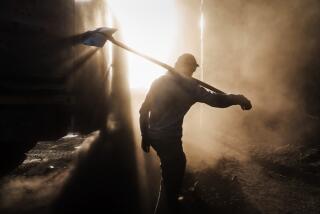Suicide bombing in Kabul kills as many as 13 Americans
Reporting from Kabul, Afghanistan, and New Delhi — As many as 13 Americans were killed Saturday when a suicide bomber struck their armored military bus in Kabul, in what may be the single deadliest attack on U.S. citizens in the Afghan capital since the war began a decade ago.
A U.S. official said the death toll was believed to be 13 U.S. citizens: five service members and eight civilian contractors. But, the official said, a Canadian and at least one British national could also be among the dead. The full extent of the casualties was unclear, he said, because the massive explosion had made identifying the dead difficult.
The Afghan Interior Ministry said at least three Afghan civilians and one policeman were also killed in the blast.
The bombing represents a propaganda coup for the Taliban, which claimed responsibility in text messages to news organizations, saying it had packed a four-wheel-drive vehicle with at least 700 pounds of explosives.
Deadly attacks are relatively rare in Kabul, which has better security than the southern and eastern parts of Afghanistan. In recent months, however, with the U.S.-led coalition announcing plans to turn security over to Afghan forces by 2014, the Taliban has stepped up assaults in a bid to bolster its political grip after the pullout.
Saturday’s carnage came a month and a half after insurgents launched a brazen 20-hour assault on the U.S. Embassy in Kabul, killing more than a dozen people. That attack was widely viewed as an attempt by the Taliban to send a message that no place in the country was secure or out of its reach.
According to the United Nations, violence across Afghanistan is at its worst since the war started in 2001, despite the presence of 130,000 foreign troops.
The NATO coalition says the number of insurgent attacks is declining, but its data don’t include lethal attacks against civilians or those mounted against Afghan security forces operating without international help.
The Kabul car bombing took place Saturday near the American University on Darulaman Road, among the capital’s busiest toroughfares, which runs past the parliament building and the decaying Darulaman Palace, or “abode of peace.”
A North Atlantic Treaty Organization spokesman said the troops and contractors were traveling in a type of military bus known as a Rhino, named for its heavy armor. The identities of those killed in the attack were not disclosed pending notification of kin.
It was the largest single-day U.S. loss in Afghanistan since August, when a helicopter was shot down in Wardak province, killing 30 U.S. troops, including 17 Navy SEALs, along with eight Afghan troops.
In preparation for the transfer of responsibility to Afghans, coalition training of Afghan police and army personnel has expanded. Darulaman Road is part of a route often taken by trainers traveling in buses and other vehicles between Kabul’s military training center and heavily fortified NATO bases in downtown Kabul.
Buses, even when heavily armored, are relatively soft targets and generally travel in convoys. But Kabul’s crowded streets and chaotic traffic make it difficult to keep a perimeter around convoys, and suicide car bombers often try to insert themselves between convoy vehicles for maximum damage.
Afghanistan’s Interior Ministry condemned the suicide attack and extended its condolences to victims’ families.
In another deadly incident, an attacker wearing an Afghan military uniform opened fire on foreign troops in Kandahar province in southern Afghanistan and killed three of them before others returned fire and killed him.
The Australian Broadcasting Corp. said three Australian soldiers and an interpreter were killed, and seven soldiers were wounded.
Analysts said attacks on foreign troops by those wearing Afghan uniforms offer several advantages from the insurgents’ perspective, whether carried out by soldiers “turned” by the Taliban, or by insurgents who make, buy or steal uniforms and ID cards for their attacks.
These allow attackers to get inside a base or otherwise much closer to foreign forces than otherwise possible. They increase distrust between Afghan and foreign forces, causing Western troops to be suspicious and even dismissive of Afghan soldiers at a time when the number of combined counterinsurgency operations are growing as 2014 approaches.
In a third incident in eastern Afghanistan, guards fired on a female suicide bomber wearing a burka as she tried to enter a government building, prompting her to detonate her explosives.
She was the only fatality in the incident, which occurred near a branch of the National Directorate of Security, the country’s spy agency, according to Abdul Sabor Allayar, Kunar province’s deputy police chief. Two agency employees and two civilians were wounded.
On other fronts, the coalition said Saturday that its troops and Afghan security forces had captured two leaders of the militant Haqqani network in a joint operation Friday in Paktika province along the Pakistani-Afghan border.
One leader had provided insurgents with funding, weapons, supplies and havens, the coalition said, and the other coordinated attacks against Afghan forces.
Magnier reported from New Delhi and special correspondent Baktash from Kabul. Times staff writer Melanie Mason in Washington contributed to this report.
More to Read
Sign up for Essential California
The most important California stories and recommendations in your inbox every morning.
You may occasionally receive promotional content from the Los Angeles Times.










